-
收藏模板
- 模板信息
- 更新时间:2023-09-07
- 字数:约23554字
- 页数:约21页
- 格式:.doc
- 推荐版本:Office2016及以上版本
- 售价:5 金币
您可能喜欢的文档
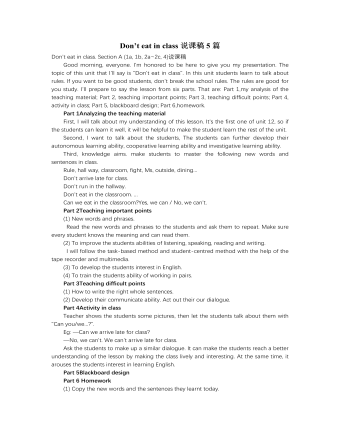
人教版新目标初中英语七年级下册Don’t eat in class说课稿5篇
TASK1. Enjoy our life.(导入新课)目的:为新课的教学作好铺垫,营造轻松的教学环境。教具:CAI操作:首先在优美轻松的乐曲中欣赏一组学生学习生活的录象,来拉开本堂课的序幕,吸引学生的注意力。以自由谈话的方式,询问学生:Do you like our school? Do you enjoy ourselves in our school?TASK2.School rules目的:用图片,以直观教学发引入School rules的教学。操作:首先通过设问,Can we listen to the music in class? Can we eat in class? 指出我们必须在合适的时间和地点做合适的事,在校我们必须遵守学校的规章制度。但是仍然有人破坏,在违规。呈现一组学生违规的图片,并问:What rules are they breaking?arrive late for class, run in the hallways, eat in the classroom, listen to the music in th classroom, fight 以此教学school rulers 并完成课文1a Match 部分教学。与此同时,在这一过程中较直观地完成 语言项目祈使句以及can表示许可的用法的介绍TASK3.Do you have clever ears?目的 :听力教学.在这里我将1b,2a,2b集中在一起教学,这样有利于训练学生的听力。
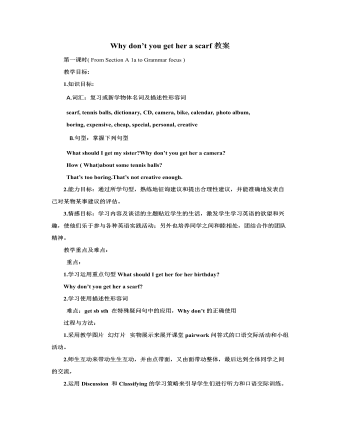
人教版新目标初中英语八年级下册Why don’t you get her a scarf教案
教师带领学生复习有关描述宠物的词汇,采用教师提问学生回答的方进行。如:T:What animals do you think would be good pets?What animals do you think would be bad pets?What do you think are good animals for a six-year-old child?然后学生进行 pairwork 练习。Task two: 师生互动,学习探究 1、播放3a部分的录音,引导学生一边听录音,一边跟读。2、通过听录音学生回答以下问题:Why do you think pot-bellied pigs are popular?What are the advantages and disadvantages of keeping such a pet?教师对学生的回答进行及时点评。3.学习范文,学习重点短语,为下步的模仿写作提供语言素材。T :1. )Have you ever kept a pig as a pet?Do you like pigs? St.:No.…Why don’t you like to keep a pig? St: No.They’re too dirty and lazy(Do you know in some foreign countries like Hollyland, Australia,pigs are the most popular pet.there’s a kind of pig.(图)it has an interesting name? it ‘s called a pot-bellied pig.) Now,let’s learn an article about this kind of interesting pet.2.)play the tapeSt.:Listen and repeat3.)show some Qs on computer(本子St.: read silently,then answerthe Qs(本子)4.)Ask ss. Close book and retell this passage.(what is a pot-bellied pig? Is it a good or bad pet? ) St.: retell it to each other“A pot –bellied pig is a popular pet now…”5.read the article together.St.:.practice reading
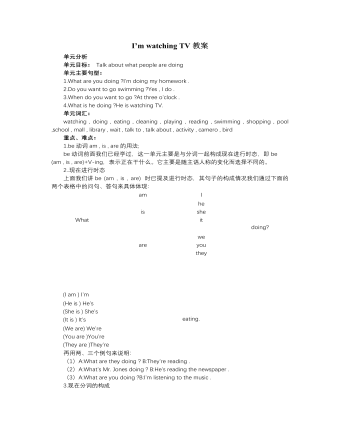
人教版新目标初中英语七年级下册I’m watching TV教案
单元分析单元目标: Talk about what people are doing 单元主要句型:1.What are you doing ?I’m doing my homework .2.Do you want to go swimming ?Yes , I do .3.When do you want to go ?At three o’clock .4.What is he doing ?He is watching TV. 单元词汇:watching , doing , eating , cleaning , playing , reading , swimming , shopping , pool ,school , mall , library , wait , talk to , talk about , activity , camero , bird 重点、难点:1.be动词am , is , are的用法;be动词前面我们已经学过,这一单元主要是与分词一起构成现在进行时态,即be (am , is , are)+V-ing,表示正在干什么。它主要是随主语人称的变化而选择不同的。2..现在进行时态上面我们讲be (am , is , are) 时已提及进行时态,其句子的构成情况我们通过下面的两个表格中的问句、答句来具体体现:3.现在分词的构成现在进行时态中be + V - ing 的构成中V-ing被称为现在分词,它的基本构成是动词原形+ing,但也有些特殊情况,下面分几类说明:(1)一般情况+ing如:read→reading,go→going,do→doing,look→looking,listen→listening,watch→watching.(2)以不发音的e结尾的词,去掉e,再加ing.如:write→writing,skate→skating,type→typing,wake→waking,make→making
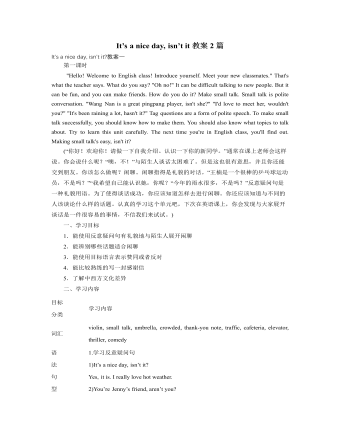
人教版新目标初中英语八年级下册It’s a nice day, isn’t it教案2篇
"Hello! Welcome to English class! Introduce yourself. Meet your new classmates." That's what the teacher says. What do you say? "Oh no!" It can be difficult talking to new people. But it can be fun, and you can make friends. How do you do it? Make small talk. Small talk is polite conversation. "Wang Nan is a great pingpang player, isn't she?" "I'd love to meet her, wouldn't you?" "It's been raining a lot, hasn't it?" Tag questions are a form of polite speech. To make small talk successfully, you should know how to make them. You should also know what topics to talk about. Try to learn this unit carefully. The next time you're in English class, you'll find out. Making small talk's easy, isn't it? (“你好!欢迎你!请做一下自我介绍。认识一下你的新同学。”通常在课上老师会这样说。你会说什么呢?“噢,不!”与陌生人谈话太困难了。但是这也很有意思,并且你还能交到朋友。你该怎么做呢?闲聊。闲聊指得是礼貌的对话。“王楠是一个很棒的乒乓球运动员,不是吗?”“我希望自己能认识她,你呢?“今年的雨水很多,不是吗?”反意疑问句是一种礼貌用语。为了使得谈话成功,你应该知道怎样去进行闲聊。你还应该知道与不同的人该谈论什么样的话题。认真的学习这个单元吧,下次在英语课上,你会发现与大家展开谈话是一件很容易的事情,不信我们来试试。)
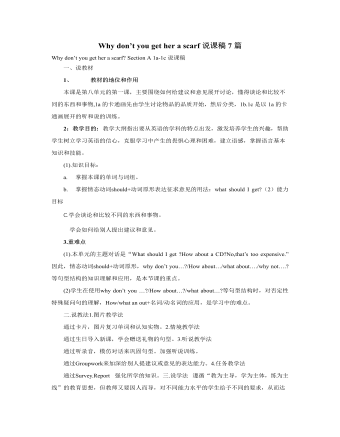
人教版新目标初中英语八年级下册Why don’t you get her a scarf说课稿7篇
[设计意图: 该环节可让学生展示自我,拓宽运用英语能力,把所学的知识在实际交流中进行运用,实现新课程倡导的“为用而学, 在用中学,学了就用”,从而提高学生综合运用英语的能力。选择母亲节来临为母亲选择礼物这一话题也是借此机会对学生进行感恩教育,并在学生的热烈讨论中告诉学生gift can’t be everything, everything can be a gift.使学生的情感得到升华。] Step9 Summary T: What have we learned in this class? Presents/ Gifts Comments Suggestions Album----special Why don’t you … Bicycle----useful Why not … +V原形 Calendar----interesting How about … Scarf----personal What about … +V-ing/ 名词 [设计意图:此环节的设计,有助于理清脉络,进一步巩固所学知识。] Step10 Homework 1. listen to 1b (do 1b and imitate ) 2. Write down your dialogue 3. Surf the internet about the differences of gift giving between China and foreign countries. [设计意图:作业1听力,由于1b听力和后面的2a相似,所以课堂上不再重复做,将其留做课后作业,上课下课时刻关注学生听力能力的培养和训练。2是将学生课堂上的说落实到课后的写。3是让学生通过自主学习,了解中西方文化的差异。分层次布置作业,体现出因材施教的教学理念。]
- 查看更多相关Word文档
Don’t eat in class教案2篇
教材分析:
中心话题:rules。
语言目标:谈论并制定某些规章制度
语言结构:祈使句、情态动词can表示许可的用法和情态动词have to 及其各种句式的变化。
SectionA提供了本单元教学的基本词汇和语言结构。

SectionB是让学生在掌握了Section A的基础知识后进行拓展和延伸。
•SectionA介绍学校生活
Words:rule, arrive, classroom, dining hall, hallway, outside, fight, uniform, sportsshoes, gym, have to
Sentences:Don’t eat in class.Can we listen to music in class? No, we can’t. But we canlisten to it outside. Do you have to wear a uniform in school? Yes, we do.
Wehave to wear sports shoes for gym classes.
•SectionB 由学校生活过渡到家庭生活,制定家规、了解标识,并引导学生展开思维与想象,进行与现实生活相联系的再创作。
•Selfcheck自我检测和评估,巩固本单元的学习任务
重点与难点分析:
•祈使句
•情态动词can表示许可的用法;
•情态动词have to
•各种可以用在表述规章制度的动词和句型
教学目标
1.能力目标
通过本单元的学习,学生能熟练使用目标语言用口头或书面描述规则,能用英文表达一些标志的含义,能谈论对某些规章制度的看法。
2 认知目标
.词汇: rules, arrive late for class, go out , practice,
inclass, classroom, halllways, outside, uniform, fight, etc.
熟练运用祈使句的否定与肯定形式。
熟练运用can表许可的一般疑问句及回答。
熟练运用have to 表达必须遵守的规则。
3情感目标
v学习规章制度,规范自己行为。
v学会与他人讨论规章制度,发表自己的认识,提出改进措施,以便自己和他人能更好地遵守。
v通过小组对话,讨论,调查和设计等一系列的课堂活动,培养学生寻求帮助,乐于与他人合作的精神。
4学习策略
v交际策略:树立正确的纪律观念,养成良好的遵守纪律的习惯,学会在人际交往等方面树立良好的行为礼貌意识。
v资源策略:学会利用一切可利用的学习资源,如词典,音像资料,
v认知策略:积极思考,及时反馈。
v调控策略:在反思,顿悟和自醒中,不断调整自己的学习策略。
5跨学科学习
•人际交往
•逻辑推论
•哲理思考
教学策略
任务型教学策略:新课程倡导“任务型”的教学途径,培养学生综合语言运用能力,并以“能做某事”作为评价标准。在设计“任务型”活动时,应该结合学生实际,力求设计出真实、切实可行的活动。
开放性教学策略:开放性地处理教材,结合教材插入学生感兴趣的图片、电影片段等,丰富学生知识,拓宽他们视野,实现知识的整合
四课时,具体安排如下:
Period1 :Section A 1a,1b,1c,2a,2b, 2c
Period2: Section A3a,3b,4,Section B:3b
Period3: Section B 1,2a,2b,2c,3a, 3c, 4
Period4: Self check
Period One
SubTopic:Talk about the school rules
Languagefocus: Imperatives ,Can for permission
Vocabulary:rule, arrive, classroom, dining hall,hallway, outside, fight
LanguageStructure:Don’t eat in class. Can we listen to musicin the classrooms or in the hallways? Yes, we can. No, we can’t.
Tasks:Listing, discussion & Making a survey
Teachingsteps:
Step1.Pre-task
Tellthe students that we will learn rules today by showing the picture ofrules.(Teacher can decide how to present the topic according to the actualsituation, for example, you can tell the students that you are unhappy becausesome of the students are not ready for class. Then present the topic :rules,tell the students everyone must keep the rules, etc.)
Showpictures and ask the students about some rules, then present the sentencestructure: Don’t ------ . You can do it as the following:
A:Can we arrive late for class?
B:No, we can’t.
A:so, don’t arrive late for class.
A:Can you fight?
B:No, We can’t. We can’t fight.
A:So, don’t fight.
Showother pictures and go on talking about the rules like the following:
Wecan’t eat in the classrooms.Don’t eat in the classrooms.
Wecan eat outside We can eat in the dining hall.
(meanwhile,teach the new words :outside and dining hall.)
Wecan’t talk in class.Don’t talk in class.We can talk after class.
Showa picture of the hallway, teach in the hallways and say:
Don’trun in the hallways.
Goon showing other pictures which may not from the unit but very useful.
We can’t draw on the wall.
Don’t draw on the wall.
Wecan’t spit(吐痰) here.
Don’t spit here.
Step2 while- task
Task1 Listing competition
T:There are many school rules in our school. Let’s list what we can’t do and takesome notes as quickly as you can.Then report them.
School rules | |
What we can’t do | What are our school rules? We can’t ------.
|
| |
| |
| |
Thenask the students change the sentences into imperative as the models.
Presentand check the rules by showing the board
School rules
1. Don’t arrive/be late for class.
2. Don’t run in the hallways.
3. Don’t eat in the classroom.
4. Don’t listen to music in the classrooms or the hallways.
5. Don’t fight.
Task2Match the pictures with the rules
Show pictures and let the students match in order to consolidatethe new words and sentence structure.
( ) Don’tarrive late for school.
( ) Don’teat in class.
( ) Don’ttalk in class.
( ) Don’trun in the hallway.
( ) Don’tfight.
( ) Don’tdraw on the wall.
( ) Don’tspit here.
Showa picture from Section A. Ask the students the following questions and let themtry to answer:
Arethey good students?
Whatrules are they breaking ?
Task3Listen.What rules are these students breaking? Write the number after the names.
FinishSection A 1b.
Task4 Listen
FinishSection A 2a and 2b.
Task5 Report
Findout what Alex and Christina can do and what they cannot do.
ByTask 5, we can make the students listen and note the content very carefully .
School rules | |
What they can’t do | What they can do |
listen to music in the classrooms or hallways. | listen to it in the music room |
eat in the classrooms | eat in the dining hall |
wear hats in class |
|
fight with anyone |
|
Step 3
Task6Add more school rules.
According to the above steps, let the add more school rules sothat they can express the rules as they like.
Don’tlisten to music in the classroom or hallways .
Listento music in the music room.
Don’teat in the classrooms.
Eatin the dining hall.
Don’twear hats in class.
Don’tfight with anyone.
Thentell the students the following phrases.
schoolrules
keep the rules 遵守规则
break the rules违反规则
Homework
•Ask students to find out some signs around them and try to drawthem out.
Period Two
Sub Topic: Talk about the school rules
Language focus: Do we have to ---? No talking, no wet umbrellas
Structure: We have to clean the classroom every day.
Dowe have to wear a uniform?
Youdon’t have to ---.
Tasks:•Listing•Making a survey
Teachingsteps:
Step1.warmingup
Watcha segment of “逃学威龙” and see what rules they are breaking ?(他们违反了哪些规章制度)let the students answer :
Don’tplay balls in class. Don’t smoke. (吸烟)。Don’t drink. Don’t wear hats. Don’t run.
Don’tsleep. Don’t fight…
Step2 Discuss
1.What do you think of the students in the movie?
2.Canyou keep(遵守) the rules?
3.How can you be a good student?
Step3 Present
Askthe students what they can or can’t do as a good student.
Showa model girl to the students and ask:
Canwe have a gym class like the girl?
Dowe have to wear sports shoes in gym classes? Yes, we do.
Wehave to wear sports shoes for gym class.
(Teachsports shoes)
Step 3 Practice
Makethe students practice the following sentence structure by showing the schoolrules.
Dowe / you have to …? Yes, I do./No, I don’t.
School rules
1. Clean the classroom every day.
2. Get to school before 7:20.
3. Wear sports shoes for gym class.
4. Keep quiet in class.
Step4.While –task
Task1.groupwork
1.askand tick the things they have to do at school first, then make a report.
Finish homework on time() | Help each other() |
Clean the classroom() | Wear a uniform every day() |
Keepall school rules () | Study hard () |
Be polite() | …… |
2.Make a report : At school, my friends have to …
Task2.ShowSs a picture of the school library.Let them talk about it.
S1: Can we …? S 2: Yes, we can. / No, we can’t.
Task3Group work
Askstudents to show the signs they found before class and explain their meanings.
Say: there are some signs in English in ourdaily life. What other places do you think need English signs and rules oncampus? Let’s work out together.
Ask them to work in groups of four and makerules for the library. Choose the best group. Ask them to write out.
Model:Rules in the library
Isthere a library in the school? Do you know the rules in the library? There is alibrary in our school. Let me tell you its rules.
You can study and do your homework there, butremember to be quiet. There are many kinds of books and magazines in thelibrary. You can read them there, or you can borrow them home. But please keepthem clean and don’t make them dirty. You can use the computers in the libraryto look for information, but you can’t play games there.
Whatabout the rules in your library? Can you write them down?
Task4.Readthe signs and explain their meanings.
Doyou know the rules for the school library?
Showthe pictures of the rules for the school library.
Task5 Make the library rules , then exchange their ideas.
LibraryRules:
Don’twrite on books, magazines, desks, or walls.
Don’teat or drink in the library.
Don’trun or fight inside.
Don’tlisten to music inside.
Don’tuse the call phone inside.
•Nofood!
•Nowet umbrellas!
•Nolistening to music!
•Notalking!
•Noschool bags!
Task6.Groupwork Discuss about the rules for the public places and make the rules.
Showeach picture for the lab, the computer room , the dining room and the swimmingpool ,make the rules for the public places .(each group can choose one publicplace )
Task7do you know these signs.
Showmore signs and make the students discuss and express .
Homework:
•Tosum up some rules of the public places
•Tofind out some signs around us and try to draw them out.
PeriodThree
SubTopic: Talk about the house rules
Languagefocus: I have to ---He /she has to ---
Vocabulary:Practice, go out on school nights,
LanguageStructure: I have to practice my guitar every day. I have to be in bed by teno’clock.
Tasks:•Listing •Comparing•Sharing
Teachingsteps:
Step1.pairwork
Makethe students ask and answer the following questions:
Doyou have to get up at 6:00?
Canyou watch TV on weekdays?
Doyou have to wash your clothes?
Canyou go out on school nights?
Doyou have to clean your bedroom?
Doyou have to be home at 5:00?
Canyou play computer games?
Step2.Pre-taskand while-task
Tellthe students what they can do to be a good child at home.
Talkwith Ss about the house rules on weekdays and weekends.
Modle:
•Amy:Hello, Ian.
•Ian:Hi, Amy. What are your rules?
•Amy:Well, I can’t watch TV in the evening. And I can’t go out on school nights.Then I have to do my homework every night. What about you?
•Ian:I can’t play football at noon. I have to have a good rest at noon. And I can’twatch TV in the evening and I have to do my homework every night. Then I haveto practise guitar every day.
Task1Make the students ask and answer about their house rules.
Task2 Interview: Go around the classroom and interview four of your friends thefollowing questions.
Item
Name | What you can’t do?
| What you have to do?
| |
|
|
| |
|
|
|
Houserules
Task3 The signs for rules Show the pictures from Section B 1.
Whatdo these signs mean?
whatcan’t he do ? And what does he have to do ?He has to ---.
FinishSection B 1
RulesEmily Dave
_______Don’t watch TV after school_______
__a____Don’t go out on school nights_______
_______Doyour homework after school._______
_______Practiceyour guitar every day._______
Task4 .Talk about their family rules (listen and note)
Therules for Dave and Emily
Name | What they can do | What they can’t do | What they have to do |
Emily
|
| Go out on school nights Hang out with my friends after school Watch TV after school | Do homework Clean her room every weekend
|
Dave
| Go out
| Watch TV after school
| be home by 10 o’clock Do homework Practice the guitar Clean his room every weekend |
Emilycan’t ---. She has to do her home on school nights.
FinishSection B 2a and 2b.
Task5 Making some rules
Listenand Find the rules for Zhao Pei’s house.
ZhaoPei’s Rules
getup at 6 o’clock
can’tmeet her friends after school
hasto take her dog for a walk after school
can’twatch TV on school nights
hasto be in bed by ten o’clock
hasto clean her room and wash her clothes on weekends
hasto help her mom make dinner
hasto learn the piano
FinishSection B 3a
Task6.Writea letter to your parents to give them some advice.
Model1:
Dearparents,
Itisn’t fair. We have too many rules at home. We want freedom. Freedom! Freedom!Now, here are the rules for you:
1.Nosmoking in the living room.
2.
3.Kids
Model2
Dearparents,
Weknow you love us, though we sometimes have different opinions. You just want usto be good. But now we grow up and hope to do things in our way. We shouldrespect each other. Would you like to have a look at the suggestions?
1.Please don’t smoke in the house.
2.
3.Love,
kids
Step3.sing a song
Can we wear hats in school? No, we can’t. No, we can’t. Can we listen to music? Yes, we can! | Can you watch TV after school? Yes, I can. Yes, I can. Can you go out on school nights? No, I can’t. |
What else do we have to do? We have to eat in the dining hall. Do we have to wear a uniform? Yes, We do. | What else do you have to do? I have to practice guitar every day. Do you have to clean your room? Yes, I do. |
Homework:
Introduce your family rules.
Ask the students to write the suggestions to their parents or teachers. forexample, “No smoking , dad.”
Helpzhao Pei give some suggestions to her parents.
Period Four
Sub Topic: Talk about the rules
Language focus:have to, don’t, can/can’t
Vocabulary: All the words and expressions in the unit
Language Structure: Don’t ---.We can’t ---.We have to ---
Tasks: Listing •Imagination•Sharing
Teachingsteps:
Step1.warming up
Singand fill in the blanks
____ we wear hats in school? No, we ____. No, we_____. Can we listen to music? Yes, we can! | Can you watch TV after school? Yes, I can. Yes, I can. Can you ___ ____on school nights? No, I can’t. |
What else do we ___ ____ do? We___ ____eat in the ___ _____. Do we have to wear a ____? Yes, We do. | What else do you have to do? I have to ____ guitar ___day. Do you have to clean your room? Yes, I do. |
Step2 Revision
Task1.Recall the school rules.
1.Don,tarrive late for class.
2.Dontrun in the hallways.
3.Donteat in the classrooms.
4.Dontlisten to music in the classrooms or
the hallways.
5.Dontfight.
6.Donttalk in class.
7.Dontgo out in school nights.
8.Pleasewear a uniform at school every day.
9.Nospitting!(不要吐痰!)
10.No smoking!(不要吸烟!)
Task2 Make our school rules
Dearstudents:
Inorder that we can have a good environment (环境). We should have some rules in our school. Here is somesuggestion, we hope that all of us can have a look at them.
1.Don’tsleep in class.
2.Cleanthe classroom everyday.
----
Yours
Task3 .Show Ss some school rules, then let them practise “Do we / you have to …?”.
Schoolrules
1.Keep tidy and clean.
2.Get to school before 7:20.
3.Be polite.
4.Respect each other.
Task4 Fill in the blanks
Schoolrules
1.____arrive late for class/school.
2.Don’t eat _________.
3.______ fight.
4.______ the school uniform.(校服)
5._______ wear a hat in______.
6.______ run in the ___________.
7.______ __________ music in the classrooms/hallways.
Task5.Competition
Havea competition between boys and girls, let them ask and answer questions about differentrules.
Boy1: Do we have to wear uniforms at school?
Girl1: Yes, we do. Can we run in the classroom?
Boy2: No, we can’t. …
Aftercompetition, get them to choose one of the rules and make a report about it ingroups of four.
Task6 Discussion
Discussthe following questions:
1.Who made so many rules for you?
2.Why did they make them?
3.What do you think of them?
4.Can you make better rules that everybody likes?
Task7.Ask some students to read their report and ask the other students to give somemore advice.
Task8. List the rules of the Fraser family. And imagine you are a child in theFraser family. Write a letter to Dr Know about the rules in your house.
FAMILYRULES
Don’ttalk loudly on the phone.
Don’twatch TV in the evening;.
Don’teat in bed.
Don’tgo out on weekends.
Don’tsleep late on Sunday morning.
Practicethe guitar every night.
Task9 solve the actual situation
InJiaxing Grand Theatre, what do we have to do?
Step3 Cosolidation
一、根据汉语意思完成句子。
1.不要大声说话。
____________ loudly.
2.我每天不得不在6:30起床。
I_____ _____get___ ____6:30every day.
3.上班不要迟到。
_________ arrive ______ ______work。
4.他必须在11点钟以前睡觉。
He______ _____ to go to bed________11:00。
5.在我们学校能戴帽子吗?--不能。
_____we _____ hats _____school? --No,we ________.
6.你们必须每天读英语吗?—是的。
_____you_____ _____read English every day? —Yes, we_____.
二、翻译下列词组或句子。
1.上课时2.不得不
3.禁止谈话4.禁止吸烟
5.请不要在走廊上奔跑。
6.6.请不要在教室里吃东西。
Don’t eat in class教案
一. 教学目标
1.知识目标
1).让学生识记下列的单词和短语
rule, sneaker, in class,in the hallways, in the classrooms, have/has to do, for gym class, on schoolnights, Dr Know, take my dog for a walk, be in bed, by ten o’clock , wash myclothes, help my mom make dinner, no talking, turn off the lights, waste water,talk loudly.
2). 让学生掌握下面的句型
Can we eat in school?
We can eat in the cafeteria , but we can’t eatin the classroom.
Can students wear hats in school?Yes, theycan. / No, they can’t.
2. 能力目标
1).复习,巩固“祈使句”的用法。(肯定,否定形式)
2).学习“can” 表许可的用法。
3).掌握“have/ has to”的表达方式及提问和问答。
3. 情感目标
能用英语表达和制定某些规则。
二. 教学重难点
1.“can”表请求,许可的用法是本单元的重点。
2.情感动词“have to”有第三人称单数的变化形式“has to”,还有时态的变化,如:“Do you have to …?/ Doeshe have to…?”。
3.肯定祈使句是省略掉主语的原形动词开头; 否定祈使句则是在肯定祈使句前加上“don’t”。
4.注意“No + doing”的表达结构
三.课文重难点注释
Section A
(1a)in class 表示“在课堂上”; in the classroom 表示“在教室里”;
(2a)eat outside 表示“在外面吃”,其中“outside”是“在外面”;
(3a)have to 有三单形式 “has to”,表示“必须”; 还有时态的变化。
Section B
(3a)I never have anyfriends. 其中“never”表达否定语气,但表达形式为肯定。例如:He never goes fishing.
四. 教学建议
1. 课时及内容建议
建议划分为四到五个课时:
第一课时Section A (1a-1c)
第二课时 Section A (2a- 4)
第三课时Section B (1a- 4)
第四课时Section B (3a)
第五课时Section B (selfcheck-3b)
教学方法建议:
1). 教师可根据教学目的和学生情况对教材调整,组合甚至删除;
2).在教本单元内容前可复习一册第十单元情态动词“can”表请求,许可的用法,然后以旧带新,完成本单元“can”表可能的用法;
3).完成了本单元的教学任务后,教师可根据学生的交际能力,适当对表达“许可及禁止”的句型进行分类,归纳和总结。学生注意其中的不同之处,能相互转换。
教学设计建议
(T:teacher, S: student)
1) 第一课时 (1a~1c)
步骤1 :warming up andrevision
教师进教室后,使用祈使句请学生们完成一系列动作:
Please stand up/ sitdown.
Close the door ,please.
Look at me and listento me.
Don’t open your books.
Don’t talk.
Let’s begin ourclass.
学生听教师的指令完成各种动作,教师也可将指令写到黑板上,让学生从视觉上考察祈使句的特点。
步骤2 :presentation
T: Where are you ? Are you in the videoarcade?S: No, we’re in the classroom.
教师出示书上1a 的图片,向学生提问。
a. 指着图上奔跑的男孩提问
T:What’s the boy doing? S: He’s running.
T:Where is he running?S: He’s running in thehallways.(板书,教读)
T:Can you run in the hallways? S: No, Ican’t.
T: So please don’trun in the hallways.(板书,教读)
=You can’t run in the hallways.
转载请注明出处!本文地址:
https://www.lfppt.com/worddetails_22362017.html最新课件教案文档
-

精选高中生期末评语
1、该生学习态度端正 ,能够积极配合老师 ,善于调动课堂气氛。 能够积极完成老师布置的任务。学习劲头足,听课又专注 ,做事更认 真 ,你是同学们学习的榜样。但是,成绩只代表昨天,并不能说明你 明天就一定也很优秀。所以,每个人都应该把成绩当作自己腾飞的起 点。2、 你不爱说话 ,但勤奋好学,诚实可爱;你做事踏实、认真、为 人忠厚 ,是一个品行端正、有上进心、有良好的道德修养的好学生。在学习上,积极、主动,能按时完成老师布置的作业,经过努力 ,各 科成绩都有明显进步,你有较强的思维能力和学习领悟力,学习也有 计划性,但在老师看来,你的潜力还没有完全发挥出来,学习上还要有持久的恒心和顽强的毅力。
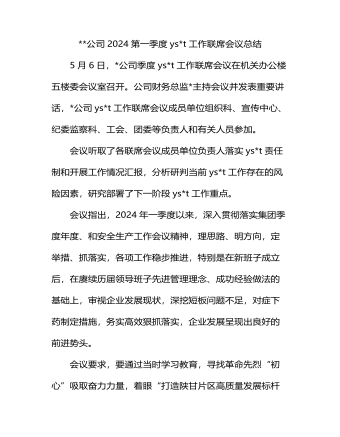
公司2024第一季度意识形态工作联席会议总结
一是要把好正确导向。严格落实主体责任,逐条逐项细化任务,层层传导压力。要抓实思想引领,把理论学习贯穿始终,全身心投入主题教育当中;把理论学习、调查研究、推动发展、检视整改等有机融合、一体推进;坚持学思用贯通、知信行统一,努力在以学铸魂、以学增智、以学正风、以学促干方面取得实实在在的成效。更加深刻领会到******主义思想的科学体系、核心要义、实践要求,进一步坚定了理想信念,锤炼了政治品格,增强了工作本领,要自觉运用的创新理论研究新情况、解决新问题,为西北矿业高质量发展作出贡献。二是要加强应急处事能力。认真组织开展好各类理论宣讲和文化活动,发挥好基层ys*t阵地作用,加强分析预警和应对处置能力,提高发现力、研判力、处置力,起到稳定和引导作用。要坚决唱响主旋律,为“打造陕甘片区高质量发展标杆矿井”、建设“七个一流”能源集团和“精优智特”新淄矿营造良好的舆论氛围。三是加强舆情的搜集及应对。加强职工群众热点问题的舆论引导,做好舆情的收集、分析和研判,把握时、度、效,重视网上和网下舆情应对。
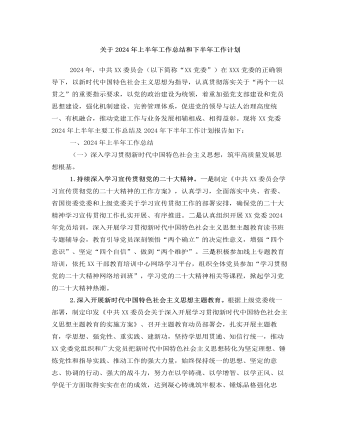
关于2024年上半年工作总结和下半年工作计划
二是深耕意识形态。加强意识形态、网络舆论阵地建设和管理,把握重大时间节点,科学分析研判意识形态领域情况,旗帜鲜明反对和抵制各种错误观点,有效防范处置风险隐患。积极响应和高效落实上级党委的决策部署,确保执行不偏向、不变通、不走样。(二)全面深化党的组织建设,锻造坚强有力的基层党组织。一是提高基层党组织建设力量。压实党建责任,从政治高度检视分析党建工作短板弱项,有针对性提出改进工作的思路和办法。持续优化党建考核评价体系。二是纵深推进基层党建,打造坚强战斗堡垒。创新实施党建工作模式,继续打造党建品牌,抓实“五强五化”党组织创建,广泛开展党员教育学习活动,以实际行动推动党建工作和经营发展目标同向、部署同步、工作同力。三是加强高素质专业化党员队伍管理。配齐配强支部党务工作者,把党务工作岗位作为培养锻炼干部的重要平台。
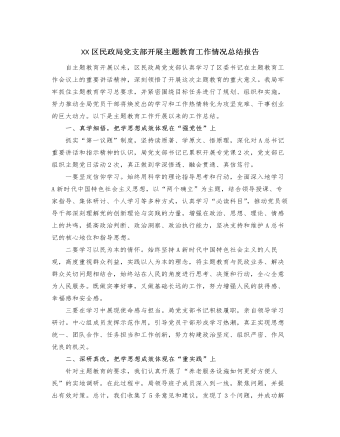
XX区民政局党支部开展主题教育工作情况总结报告
二要专注于解决问题。根据市委促进经济转型的总要求,聚焦“四个经济”和“双中心”的建设,深入了解基层科技工作、学术交流、组织建设等方面的实际情况,全面了解群众的真实需求,解决相关问题,并针对科技工作中存在的问题,采取实际措施,推动问题的实际解决。三要专注于急难愁盼问题。优化“民声热线”,推动解决一系列基层民生问题,努力将“民声热线”打造成主题教育的关键工具和展示平台。目前,“民声热线”已回应了群众的8个政策问题,并成功解决其中7个问题,真正使人民群众感受到了实质性的变化和效果。接下来,我局将继续深入学习主题教育的精神,借鉴其他单位的优秀经验和方法,以更高的要求、更严格的纪律、更实际的措施和更好的成果,不断深化主题教育的实施,展现新的风貌和活力。
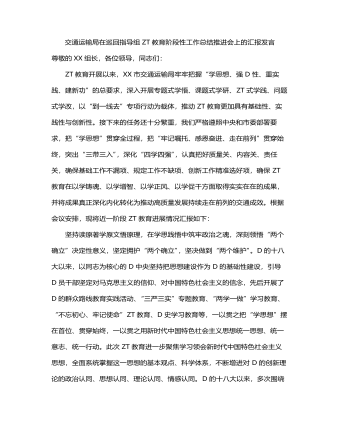
交通运输局在巡回指导组主题教育阶段性工作总结推进会上的汇报发言
今年3月,市政府出台《关于加快打造更具特色的“水运XX”的意见》,提出到2025年,“苏南运河全线达到准二级,实现2000吨级舶全天候畅行”。作为“水运XX”建设首战,谏壁闸一线闸扩容工程开工在即,但项目开工前还有许多实际问题亟需解决。结合“到一线去”专项行动,我们深入到谏壁闸一线,详细了解工程前期进展,实地察看谏壁闸周边环境和舶通航情况,不断完善施工设计方案。牢牢把握高质量发展这个首要任务,在学思践悟中开创建功之业,坚定扛起“走在前、挑大梁、多做贡献”的交通责任,奋力推动交通运输高质量发展持续走在前列。以学促干建新功,关键在推动高质量发展持续走在前列。新时代中国特色社会主义思想着重强调立足新发展阶段、贯彻新发展理念、构建新发展格局,推动高质量发展,提出了新发展阶段我国经济高质量发展要坚持的主线、重大战略目标、工作总基调和方法论等,深刻体现了这一思想的重要实践价值。
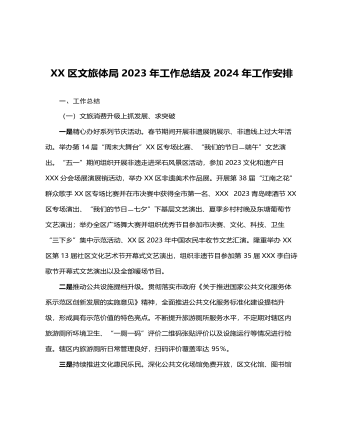
XX区文旅体局2023年工作总结 及2024年工作安排
三、2024年工作计划一是完善基层公共文化服务管理标准化模式,持续在公共文化服务精准化上探索创新,围绕群众需求,不断调整公共文化服务内容和形式,提升群众满意度。推进乡镇(街道)“114861”工程和农村文化“121616”工程,加大已开展活动的上传力度,确保年度目标任务按时保质保量完成。服务“双减”政策,持续做好校外培训机构审批工作,结合我区工作实际和文旅资源优势,进一步丰富我市义务教育阶段学生“双减”后的课外文化生活,推动“双减”政策走深走实。二是结合文旅产业融合发展示范区,全力推进全域旅游示范区创建,严格按照《国家全域旅游示范区验收标准》要求,极推动旅游产品全域布局、旅游要素全域配置、旅游设施全域优化、旅游产业全域覆盖。
今日更新Word
-

精选高中生期末评语
1、该生学习态度端正 ,能够积极配合老师 ,善于调动课堂气氛。 能够积极完成老师布置的任务。学习劲头足,听课又专注 ,做事更认 真 ,你是同学们学习的榜样。但是,成绩只代表昨天,并不能说明你 明天就一定也很优秀。所以,每个人都应该把成绩当作自己腾飞的起 点。2、 你不爱说话 ,但勤奋好学,诚实可爱;你做事踏实、认真、为 人忠厚 ,是一个品行端正、有上进心、有良好的道德修养的好学生。在学习上,积极、主动,能按时完成老师布置的作业,经过努力 ,各 科成绩都有明显进步,你有较强的思维能力和学习领悟力,学习也有 计划性,但在老师看来,你的潜力还没有完全发挥出来,学习上还要有持久的恒心和顽强的毅力。
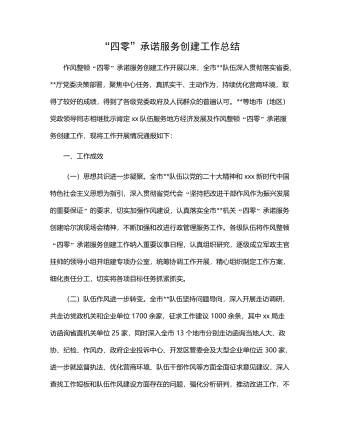
“四零”承诺服务创建工作总结
(二)坚持问题导向,持续改进工作。要继续在提高工作效率和服务质量上下功夫,积极学习借鉴其他部门及xx关于“四零”承诺服务创建工作的先进经验,同时主动查找并着力解决困扰企业和群众办事创业的难点问题。要进一步探索创新,继续优化工作流程,精简审批程序,缩短办事路径,压缩办理时限,深化政务公开,努力为企业当好“保姆”,为群众提供便利,不断适应新时代人民群众对政务服务的新需求。(三)深化内外宣传,树立良好形象。要深入挖掘并及时总结作风整顿“四零”承诺服务创建工作中形成的典型经验做法,进一步强化内部宣传与工作交流,推动全市创建工作质效整体提升。要面向社会和公众庄严承诺并积极践诺,主动接受监督,同时要依托电台、电视台、报纸及微信、微博等各类媒体大力宣传xx队伍作风整顿“四零”承诺服务创建工作成果,不断扩大社会知情面和群众知晓率。
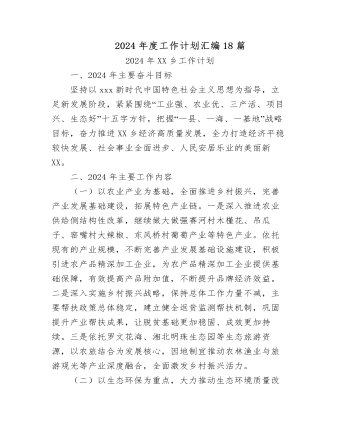
2024年度工作计划汇编(18篇)
1.市政基础设施项目5项,总建设里程2.13km,投资概算2.28亿元。其中,烔炀大道(涉铁)工程施工单位已进场,项目部基本建成,正在办理临时用地、用电及用水等相关工作;中铁佰和佰乐(巢湖)二期10KV外线工程已签订施工合同;黄麓镇健康路、纬四路新建工程均已完成清单初稿编制,亟需黄麓镇完成图审工作和健康路新建工程的前期证件办理;公安学院配套道路项目在黄麓镇完成围墙建设后即可进场施工。2.公益性建设项目6项,总建筑面积15.62万㎡,投资概算10.41亿元。其中,居巢区职业教育中心新建工程、巢湖市世纪新都小学扩建工程已完成施工、监理招标挂网,2月上旬完成全部招标工作;合肥职业技术学院大维修三期已完成招标工作,近期签订施工合同后组织进场施工;半汤疗养院净化和医用气体工程已完成招标工作;半汤疗养院智能化工程因投诉暂时中止;巢湖市中医院(中西医结合医院)新建工程正在按照既定计划推进,预计4月中下旬挂网招标。

驻村工作队2024年第一季度工作总结汇编(4篇)
三是做大做强海产品自主品牌。工作队于xx年指导成立的冬松村海产品合作社,通过与消费帮扶平台合作,在工作队各派出单位、社会团体、个人支持下,已获得逾xx万元销售额。2022年底工作队推动合作社海产品加工点扩建的工作方案已获批,待资金下拨后将正式启动扩建工作。四是积极助企纾困,带动群众增收致富。工作队利用去年建立的xx镇产业发展工作群,收集本地企业在产品销售、技术、人力、资金、运营、用地等方面的需求,并加大xx支持乡村振兴力度,xx助理赴各村委开展多场xx政策支持乡村振兴宣讲活动,本季度有x万元助农贷款获批,xx万贷款正在审批中。在壮大既有产业的同时,完善联农带农机制,一方面鼓励企业雇用本地农户就业,另一方面计划与本地农户签订长期收购合同,让农民种得放心、种得安心,带动当地群众共同致富。

主题教育总结常用提纲大全
第一,主题教育是一次思想作风的深刻洗礼,初心传统进一步得到回归。第二,主题教育是一次沉疴积弊的集中清扫,突出问题进一步得到整治。第三,主题教育是一次强化为民服务的生动实践,赤子之情进一步得到提振。第四,主题教育是一次激发创业担当的有利契机,发展层次进一步得到提升。2.第一,必须提领思想、武装思想。第二,必须聚焦问题、由表及里。第三,必须领导带头、以上率下。第四,必须务实求实、认真较真。3.一是抬高政治站位,坚持大事大抓。二是坚持思想领先,狠抓学习教育。三是突出问题导向,深入整改纠治。四是坚持领导带头,发挥表率作用。4.一是立足“早”字抓筹划。二是着眼“活”字抓学习。三是围绕“统”字抓协调。5.一是形势所需。二是任务所系。三是职责所在。四是制度所定。6.一要提升认识。二要积极作为。三要密切协作。
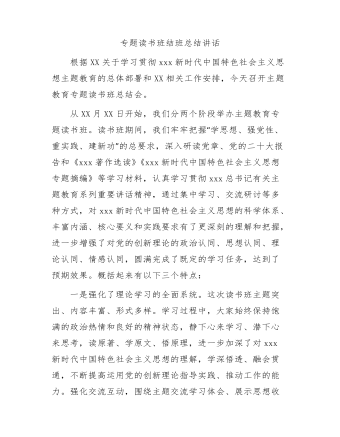
主题教育专题读书班结班总结讲话
第二,要把调查研究贯穿始终,实干担当促进发展。开展好“察实情、出实招”“破难题、促发展”“办实事、解民忧”专项行动,以强化理论学习指导发展实践,以深化调查研究推动解决发展难题。领导班子成员要每人牵头XX个课题开展调查研究,XX月底前召开调研成果交流会,集思广益研究对策措施。各部门、各单位要制定调研计划,通过座谈访谈、问卷调查、统计分析等方式开展调查研究,解决工作实际问题,帮助基层单位和客户解决实际困难。第三,要把检视问题贯穿始终,廉洁奉公树立新风。认真落实公司主题教育整改整治工作方案要求,坚持边学习、边对照、边检视、边整改,对标对表xxx新时代中国特色社会主义思想,深入查摆不足,系统梳理调查研究发现的问题、推动发展遇到的问题、群众反映强烈的问题,结合巡视巡察、审计和内外部监督检查发现的问题,形成问题清单。

















